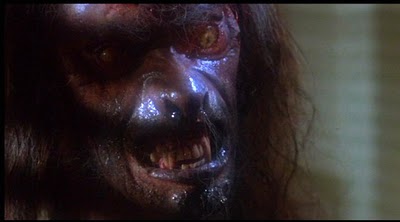 I Don't Believe in Modern Horror
I Don't Believe in Modern Horror
The Howling is the second horror movie from 1981 that I’ve watched this week. I don’t know what was going on with the genre back then but damn, could we stand to learn some lessons.
For starters, this is a werewolf movie in which we don’t see a werewolf until it’s nearly half over. The Howling begins as a stylized crime picture in which serial killer Eddie Quist (Robert Picardo) lures TV reporter Karen White (Dee Wallace) into a peep show booth. The cops and Karen’s news crew monitor her movements, but something goes wrong and the sting turns bloody. At her psychiatrist’s request (Patrick Macnee), Karen and her husband take a vacation at his wooded recovery retreat. There, they meet colorful locals, New Age hippies, and one sultry nymphomaniac. Karen also begins to have visions of bizarre, hairy half-men, and hears wolves howling in the night.
The rest of the story isn’t particularly revolutionary—at least not today—but the acting, script and direction make The Howling a great, weird horror thriller. It’s part monster movie, part black comedy; a style director Joe Dante would continue to hone in his segment of The Twilight Zone: The Movie , Explorers, and his most famous film, Gremlins.
Take the scene in which another reporter, Terry (Belinda Balaski), sneaks into the retreat to dig up a file on Eddie Quist, who was also under the care of the psychiatrist. She talks to her boyfriend on the phone while rifling through a file cabinet, and grows increasingly frustrated when the documents she needs don’t turn up. Suddenly, a giant clawed hand reaches into frame, handing Terry a file folder; she looks up to see a nine-foot monster standing in front of her. It’s a solid jump scare, but it’s also ridiculous—and, since this is the first time we see what the werewolf really looks like, it’s also kind of terrifying. The beast strangles and mangles Terry, a character to whom we’ve grown to like. The moment of her death feels tragic—until it’s undermined by a cut back to the boyfriend on the other end of the phone, who’s got a copy of Allen Ginsburg’s Howl sitting on his desk (he may have also been drinking Wolf coffee).
The offbeat storytelling is enhanced by Dante’s visual style, which feels inspired by the EC Comics of the 50s. The Howling is all skewed angles, dramatic close-ups, and a rich color palette that—when combined with his use of both extreme shadows and haunting twilight haze—give the movie a dreamlike quality.
It also helps that there are so many great faces and inspired cameos in the film. Monster movie fans and character-actor groupies will flip when they recognize Roger Corman, Slim Pickens, Forrest Ackerman, and Dick Miller (side note: is Dick Miller the best character actor in the history of film? Even though he plays a variation of the same guy in almost every movie, he manages to bring some new, indefinable thing to his roles that never fails to make me smile). All of the actors Dante chose bring a larger-than-life quality to the movie; they all look like they jumped out of a comic book and onto the screen. This serves to not only keep us involved in what’s going on, but also allows us to join Karen on her descent into paranoia. That’s not to say that the supporting performances are parodies—I really believed that half the cast was nuts.
The Howling came out in the same year as An American Werewolf in London, and shares that film’s reputation for groundbreaking transformation effects. I won’t compare the two right now, as it’s been awhile since I saw the other film, but I will say that effects master Rob Bottin took a different approach than I’d expected. Besides the requisite skin stretching and snout morphing, Bottin added a bubbling effect that looked alternately creepy and dodgy. And while I appreciate that this was in part an effects showcase, I think the transformations took up a bit too much screen time.
I don’t know when Hollywood lost its magic in regards to horror films (probably around the same time as The Howling III: The Marsupials), but what passes for great genre filmmaking has been on the decline for almost thirty years. It’s a disgrace that someone could put out a bloated, bloodless cash-in like The Wolfman remake and call it a horror movie; The Howling is a lean ninety minutes of scary fun, starring adults and written for them.
In fact, I think The Howling should be re-released in theatres today, in place of The Wolfman. You wouldn’t need to re-cast it or cut it; just put the movie out again. Promote it heavily, and watch people go nuts. Sure, MGM would probably farm out some effects touch-ups to Lucasfilm—there are sequences in which the werewolves in the movie are actually cartoons—but much of the practical work still holds up. This movie is so original and smart that I don’t think modern audiences would know what hit them.

